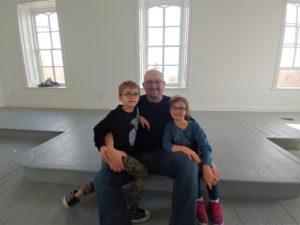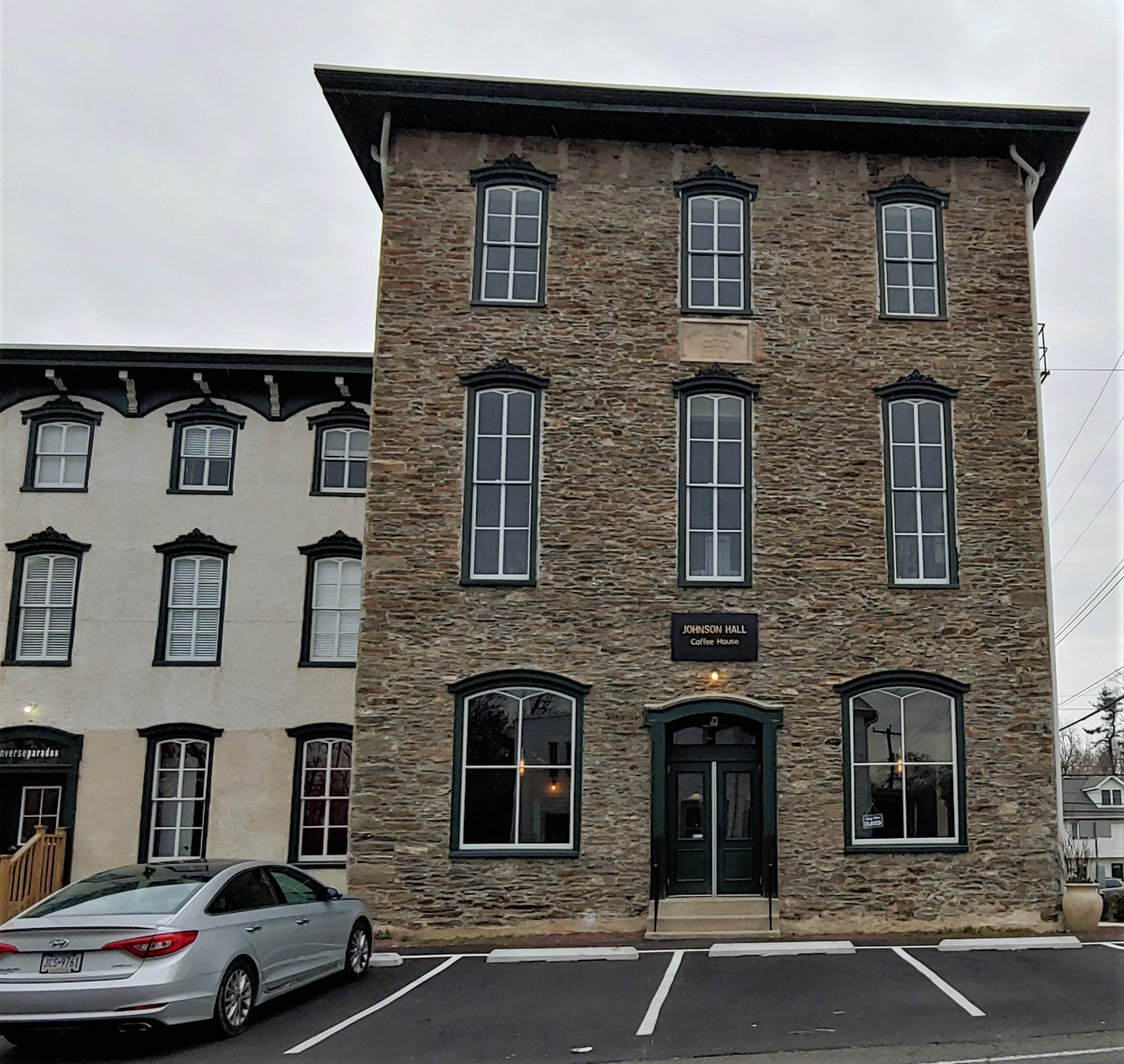Hulmeville is ‘over the moon’ about
the rebirth of 148-year-old Johnson Hall.
It was near closing time that my adventure pal Wynne Wert and I arrived for a peek at the reborn Johnson Hall, the centerpiece of old Hulmeville. Inside the ground floor coffee house, proprietor Eriola Covrljan of Lower Makefield greeted us, all smiles. After all, this was her dream and that of her family and their partner who have completely renovated the 148-year-old, three-story hall and its attached 3-story former residence. The coffee house and Sharon Dachino’s boutique/wedding/event planner are on the ground floor of the hall. Katey Olivia Smyth’s Flex Force fitness studio is on the second, and a photographer is soon to open a studio on the third. The Johnson House also is fully leased to Neil Garner and his Inverse Paradox local tech company.

“People in Hulmeville are over the moon about our opening,” enthused Eriola, taking a break from behind-the-counter duties with manager Matthew Cummins and occasional help from her eldest daughter, Emma, 11. Eriola offers breakfast and lunch with plans to expand the menu with creative items in coming weeks. She’s also considering live performances by area musicians in the coffee house, open daily from 7 to 3.
I visited Johnson Hall last year when work was underway, a massive undertaking that required Eriola’s husband Alex and partner Dimitry Gitarts of Langhorne to fully rehab both the hall and the house – from reinforcing the basement to full electric, plumbing, roofing, fire safety, air conditioning and heating. Historical restoration of all the windows attracted Wynne’s attention having visited the building years before.
On a recent tour with Alex and his bubbly children Mia, 8 and Mason, 6, he emphasized how many Hulmeville area craftsmen contributed to the renovation. Barry Harrison of Harrison’s Ornamental Iron, Chris Fullan of Forever Hung Windows and Marko Cotic of Noan Kitchen and Bath to name just a few. “It was a significant undertaking to say the least,” said Alex.

The use of local trades certainly would have gotten a thumbs up from Hulmeville founder John Hulme Jr. a few years after George Washington won the American Revolution. For Hulme, the idea was to build a town at a scenic location where his many sons could become craftsmen at local industries. That way he’d achieve his goal: keeping his family together in one spot. The site chosen was near a grist mill and a busy wagon crossing of Neshaminy Creek between Bensalem and Middletown. Hulme, 46, got to work building 30 dwellings around the mill. Soon came stores, workshops and new and expanded mills powered by the Neshaminy. By 1813, Hulmeville had a post office and a hotel. Taking up residence in the new town was young sign painter Edward Hicks who would become famous for his “Peaceable Kingdom” oil paintings.
The square-mile borough incorporated in 1872. Many mills and shops brought continued prosperity and employment. Two churches – an Episcopal founded in 1831 and a Methodist in 1840 – flourished as did a large public school and a private school. So did Johnson Hall. Town luminary John L. Johnson constructed the building in 1871 as a combination general store, meeting facility and residence. A variety of groups shared the third floor including Sons of America, Odd Fellows, Knights of Pythias, Soldiers Union of Hulmeville (Civil War), Sons of Temperance and the Boy Scouts. The second story was reserved for public meetings and entertainment with a seating capacity of 350. It was packed on the day Houdini performed, according to local tradition. The specific date and what occurred has been lost in time. But as I told Eriola over a cup of Lancaster’s Square One coffee, “Maybe Houdini’s ghost will resurrect and set the record straight like he promised shortly before his death in 1926.” The idea of a resident ghost scares the begeebees out of Eriola. “No, I don’t want that!” she exclaimed, though she will consider some sort of poster or photo of the magician “as a conversation piece.”
The 20th century was not kind to Hulmeville after all its prosperity in the 19th. Slowly all the mills shuttered and business moved out. But the scenic nature of the town tucked in at the base of steep hills on both sides of the Neshaminy make it attractive. Town folk dream of better days forecast in the restoration of the Johnson Hall. Hulmeville Historical Society member Mary Johnson, is hopeful. “We are so overlooked,” she told me last year. “We’re trying to preserve the spirit of the town. We’ve been able to do it so far.”
The new owners of Johnson Hall agree. As Alex emphasized to me during construction, “Hulmeville is well poised to succeed. There’s really nothing like it down here. You have to go deep into Bucks to find a similar setting. Hulmeville is a beautiful location with great opportunity.”
Sources include “The History of Bucks County, Pennsylvania” by W.W.H. Davis published in 1905; “Hulmeville Borough Centennial 1872 to 1972″ compiled by Howard Martin of the Hulmeville Historical Society; and resident borough historian Don Haefner. Thanks also to Rev. Lorelei Bach of Neshamony United Methodist Church in Hulmeville for her help.

